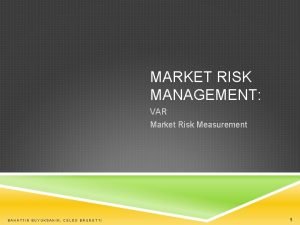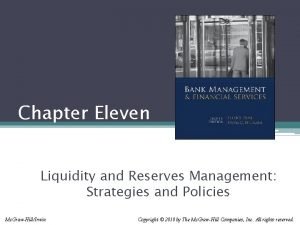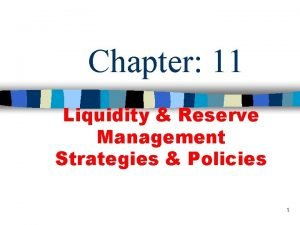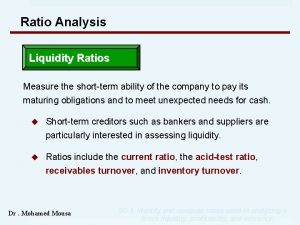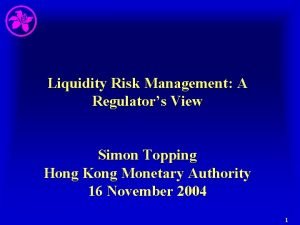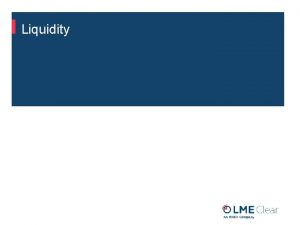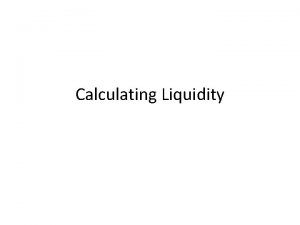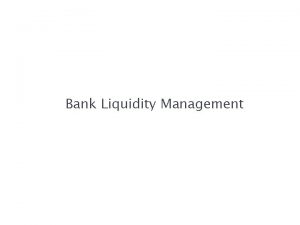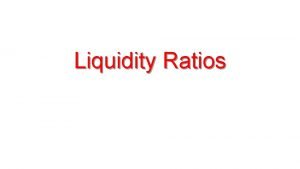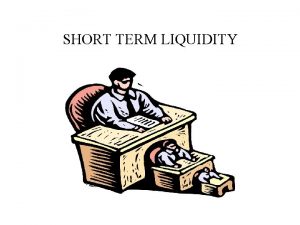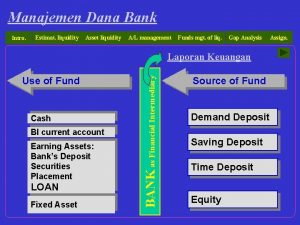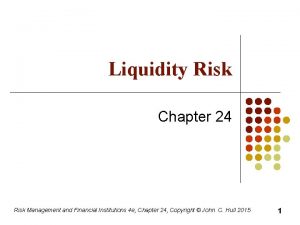Liquidity Risk Management This risk arises due to






























- Slides: 30

Liquidity Risk Management • This risk arises due to mismatch of assets and liabilities • Short term borrowing and long term lending results into this risk • Short term borrowing at lower cost and long term lending at a higher yield • Profit is ensured but liquidity risk arises • Banks need to maintain short as well as long term liquidity

Approaches to Liquidity Risk Mgt. • Fundamental Approach – To ensure long term liquidity • Technical Approach – To ensure short term liquidity

Fundamental Approach • To reduce long term liquidity risk • Adjustment of long term maturity of assets and liabilities • Diversification and broadening of sources and uses of funds • This is done by either liability creation or by assets liquidation

Assets Management • Holding near cash assets • Depending on Primary or Secondary reserve • Primary reserve – CRR • Secondary reserve – Marketable securities held for liquidity purpose

Considerations while assets management • If funds are put up in Govt. security – Liquidity, safety are higher and yield is moderate • If funds are put up in corporate instruments – Return is higher but liquidity and safety are lower

Liability Management • Sources of fund is focused • Funds are borrowed as per need • Cost of borrowing and maturity of instruments is important

Considerations while Liability Management • Interest rate fluctuation may increase cost and thereby risk • Sources and time period of borrowings to be taken into account

Applicability • Depends upon – Size of the bank – Nature of operation of bank • For small size bank – Assets management is better option – Major portion is retail deposit. Liquidity requirement is relatively low • For large size bank – Liability Management is better option

Technical Approach • Short term liquidity management • Linked to cash flow arising due to operational transaction • Bank should know its cash requirement and cash flow to ensure safe level of liquidity • For this purpose there are two approaches – Working Fund Approach – Cash Flow Approach

Working Fund Approach • It focus on actual cash position on factual data • Working Funds includes – Owned Funds – Deposits – Float Funds

Owned Funds • Liquidity for owned funds is nil

Deposits • Liquidity requirement for deposits depends upon maturity profile of deposits • Volatile funds – Current a/c, short term deposits – 100 % liquidity is required • Vulnerable funds – Saving deposits – Less than 100 % liquidity is required • Stable funds – Term deposits – Least liquidity is required

Float Funds • Funds are in transit • DD, BC, MT, TC etc • 100 % liquidity is required

Assessing liquidity position on the basis of working fund • Decide average cash balance to be maintained as a % of working fund • Decide range of acceptable variance • If average balance is within this range liquidity is ensured • If not corrective action is required – Either deploying surplus fund – Or borrowing to meet the deficit

Cash Flow Approach • It takes into account potential increase or decrease in deposits / lending • Trends can be established on the basis of historical data • Planning horizon is to be decided

Basic steps in Cash Flow Approach • Estimate anticipated change in deposit • Estimate cash inflow by loan recovery • Estimate cash outflow by deposit withdrawal and loans • Estimate liquidity need over the planning horizon • Accurate forecasting & good data collection network is required for the success of this approach

Over

Exchange Risk Management • It is the risk that arises due to fluctuation in exchange rate • Sale and purchase of foreign currency involves risk due to change in exchange rate • Exchange rate changes due to change in demand supply of foreign currency

Foreign exchange exposure • Foreign exchange exposure is the sensitivity of change in value of assets or liabilities or operating income to unanticipated changes in exchange rate • Exposure is the absolute amount of money that is at risk • Firm can set target for the level of exposure that they will be able to sustain

Types of exposure • Transaction exposure • Translation exposure

Transaction exposure • Risk due to change in exchange rate at the time of execution of transaction and at the time of settlement • Transaction exposure is because of • Import / export • Dividend paid / received in foreign currency • Loan repayment made in foreign currency

Translation Exposure • This is relating to valuation of assets and liabilities and it arises while preparing consolidated balance sheet of a bank having branches, subsidiaries abroad • Foreign currency assets and liabilities are valued at prevailing exchange rate • Possibility of loss or gain • Guidelines for valuation are issued by FEDAI and ICAI

Managing Exposure • Internal Technique – Netting – Leading and Lagging – Invoicing • External Technique – Forward Contract – Currency Future – Currency option – Currency swap

Netting • Assets in foreign currency is used to pay liability • No need for conversion • Simultaneous occurrence of inflow and outflow in same currency and same amount is pre-condition • EEFC account facility can be used

Leading and Lagging • Leading means advancing cash flow than due date • Lagging means delaying cash flow beyond due date • Conversion of currency can be avoided • Consent of the counterparty is required

Invoicing • By making invoice in domestic currency conversion and exchange risk can be avoided • Here the risk is transferred to counterparty

Forward Contract • Agreement to buy or sell foreign currency for – Pre-determined amount – Pre-determined rate – Pre-determined date • Counter party is a banker • Bank normally covers the position • Actual cash flow occurs at delivery

Currency Future • Similar to forward contract Difference is • Here there is secondary market • Future are traded on exchange • Operations as per rules, regulation and guidelines issued by exchange • Margin is required to be deposited with exchange

Currency Option • Buyer of an option has a right but not an obligation to buy or sell foreign currency • Traded on exchange • Standard size, maturity date • Guidelines are issued by exchange

Currency Swap • It is useful to change composition of foreign currency assets and liabilities • Used to exchange excess of one currency with other
 Risk classification
Risk classification Fed tapering
Fed tapering Long forward position
Long forward position 25-3/440
25-3/440 Usage variance formula
Usage variance formula Varmarket
Varmarket Example of liquidity risk
Example of liquidity risk Jerome lebuchoux
Jerome lebuchoux Balance sheet hedge translation exposure
Balance sheet hedge translation exposure Unicystic ameloblastoma
Unicystic ameloblastoma The law of increasing opportunity costs arises because
The law of increasing opportunity costs arises because One major barrier to entry under pure monopoly arises from
One major barrier to entry under pure monopoly arises from Monopoly graph labeled
Monopoly graph labeled The principal-agent problem arises primarily because
The principal-agent problem arises primarily because All that arises passes away
All that arises passes away Stored liquidity management
Stored liquidity management Balanced liquidity management strategy
Balanced liquidity management strategy Liquidity management strategies
Liquidity management strategies European collateral management system
European collateral management system Liquidity and reserve management
Liquidity and reserve management Quattro lati
Quattro lati Procedural due process vs substantive due process
Procedural due process vs substantive due process Grande rhetra
Grande rhetra Conservazione del moto
Conservazione del moto Credit risk market risk operational risk
Credit risk market risk operational risk Key risk indicators financial risk management
Key risk indicators financial risk management Risk map
Risk map Liquidity premium theory
Liquidity premium theory Liquidity ratio
Liquidity ratio Money supply and credit creation
Money supply and credit creation Simon slide control
Simon slide control





